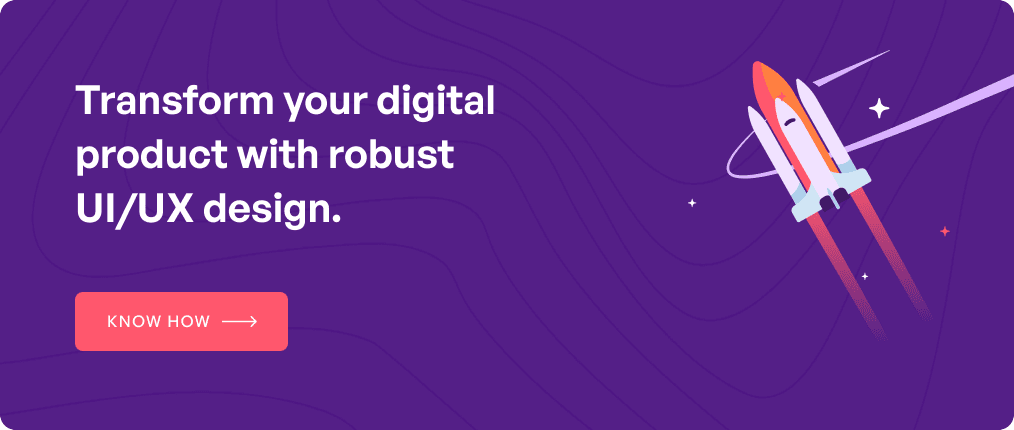Design is what stands out first when people scroll app stores or websites. Irrespective of whether this scroll is aimless or likely to turn into buying customers, it is the digital product design that subconsciously affects the decision to continue. In fact, a study by Stanford University found that 94% of first impressions are based on design. This is because visually appealing stimuli like colors and patterns are tools that encourage customers to stay longer than usual and take action. Otherwise, it slowly turns into digital dust.
This understanding of which design would make people convert comes intrinsically to a marketer. This is because they analyze user-behavior with data-driven insights. Tech entrepreneurs, on the other hand, lack in this area, since their expertise lies in developing proof of concepts and powerful digital solutions. We have written this article to simplify the journey of understanding digital product design for those entrepreneurs.
Table of contents
What is digital product design?
Digital design is not just the aesthetics that meet the eye. Developers also have to ensure that the solution, whether a software or a website, solves real problems. So, the digital product design process is a continuous effort to build user-centric solutions that are easy-to-use, instinctive, and aligns with business and user needs.
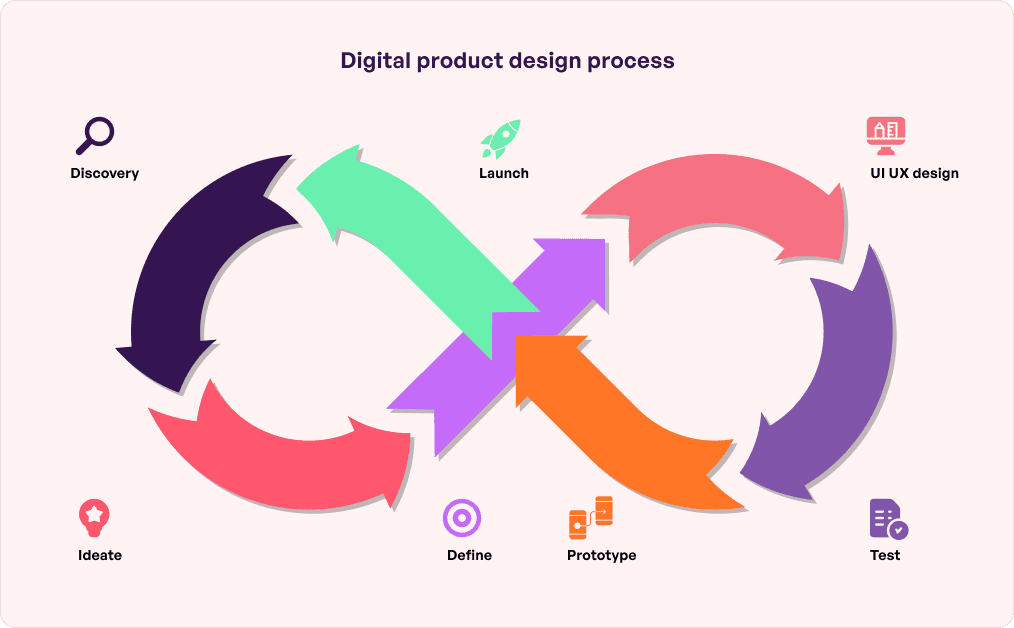 For this, the interface goes through a robust process of imaging, modifying, and building to cater to specific industries and a successful digital transformation . In addition, the essentials of digital product design includes strategy, marketing, analytics, and interaction design like UI, UX, and IxD. Altogether, the end-to-end design is a flow of digital product prototype and research to production, and finally rolling out.
For this, the interface goes through a robust process of imaging, modifying, and building to cater to specific industries and a successful digital transformation . In addition, the essentials of digital product design includes strategy, marketing, analytics, and interaction design like UI, UX, and IxD. Altogether, the end-to-end design is a flow of digital product prototype and research to production, and finally rolling out.
End-to-end digital product design process
While every digital product is different, with their separate user base, concept, and end goals, the product design process is more or less the same. Starting with gathering a detailed understanding of the users and ending with post-testing design launch, well-strategized stages of product design keep brand guidelines and users’ need at the forefront to build an immersive experience. Let us understand the process in detail.
User persona
The first stage of a digital product design process starts with building a user persona of your digital product’s real users – the people you would want to sell to through the application or website. The best way to approach this is by creating an imaginary user profile. Now step into their shoes and guess their challenges with similar digital products, what would motivate them to use your offering, and how will they use your product to achieve that goal.
While a majority of this activity is guesswork, do talk to a few real users to know what their goals and challenges are to conceptualize a more sound product idea. For this, consider similar product feedback and user interviews, polls and surveys.
Market analysis
In the user persona creation activity, you will most likely come across a list of competitors and require a high-level market understanding. So, the next step is to run a thorough market analysis in terms of your competitors, companies that offer your app’s core feature as a sub-service, and similar businesses in your industry. This is important to figure out what you can do differently to pull consumers and leave a lasting impression.
All of this, mixed with market trends. will help you get an understanding of how the industry is moving and what the users would expect.
User journey mapping
Releasing an app or website without mapping the user journey first means missing out on app’s design optimization and functionality to build a valuable product. So, with the homework done in the previous stages of product design, the next step is to create a user journey mapping chart. The chart will define how the users will move inside your app or website to achieve their goals. Remember that it must be a perfect blend of simplicity yet with a powerful impact for a user-centered design process. Building a practical user journey map also helps with –
- Understanding touchpoints that turn traffic into customers
- Visualize emotions – what motivates and what frustrates
- Build personalized experiences tailored to unique needs and preferences
- Check the efficiency of the user flow movement – steps that help complete an action
Further, the other benefits are understanding user intentions, empathizing with them, and boosting retention to expect better ROI. Keeping these in mind could be the difference between a stellar digital product with high engagement or an unrealistic one with low traffic.
Wireframe
Wireframe is another solid arrow in the quiver! These are black and white 2D skeletons that act as the building blocks of the digital product’s user experience. The layout looks like it has been created with wires and is a crucial part of the UI/UX design process. Colors and patterns are not added yet. The primary idea behind wireframes is to create a system that details how the digital product connects as the users navigate from one screen to another. They also act as a base for developers to understand the app flow. In simple terms, wireframe is a simple or interactive ‘what goes where’ stage.
Tools like Figma, Axure, Sketch, and Balsamiq are typically used by businesses to create wireframes.
User interface
Once the skeleton is ready, the next step that comes in the digital product design process is filling it with user interface elements like icons, buttons, searchbars, carousels, toggles, checkboxes, and branding segments. These elements are the point of human-computer interaction. It is here that the design system of the digital product is fixed keeping both branding and app flow in the forefront – one which sticks across every platform the digital product is active on.
For making UI a user centered design process, designers usually takes two routes –
- Competitor analysis to find the strengths and weaknesses of their product and creating a design system accordingly.
- Moodboards to coordinate and present the digital product’s visual components.
Product designers also take definition, ideation, prototyping, and testing into account when finalizing the user interface. Although the process is known to be linear, in most cases, it is highly flexible since new insights are often revealed in different stages.
User experience design
User experience is that part of the digital product design process that leads your users to create an impression about your business and motivates or inspires them to act. The stage covers elements that define the customer interactions and touch points within your digital product. This should also be ethically and legally compliant to avoid disruptions.
At Simublade, our UX designers are adept at balancing innovation with ethical and legal guidelines to ensure your business is future-proof. So, if you have an app idea, connect with us to turn it into reality.
The biggest role of a product designer when creating the user experience is to build the customer journey and find touchpoints that would make them convert into paying customers. Here are some questions that help answer that –
- How do people find out about your software for the first time?
- What should the onboarding process look like?
- What are the different user types and their user journeys?
- What should be offered to upgrade/maintain their current status in customer lifetime value?
Prototype
Digital product prototypes are the clickable format of your software. It gives you the opportunity to step into the users’ shoes and move in the product as they would. Additionally, it works as an excellent foundation for the developers to code the exact user journey as intended in the design concept.
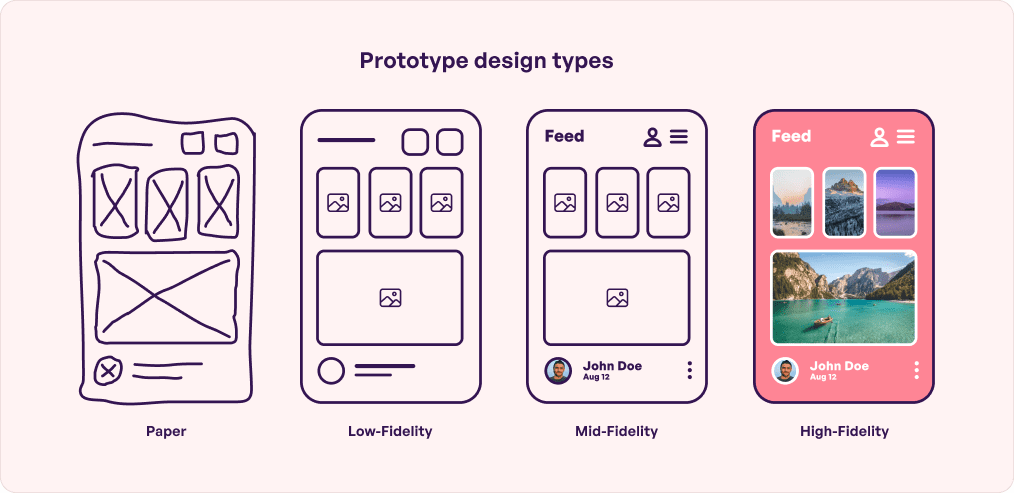 Here are the different tasks a prototype aims to solve –
Here are the different tasks a prototype aims to solve –
- Visualization of the digital product at its early stages
- Ability to make changes at a minimum cost
- Ability to give accurate estimate of budget and completion timeline
- Understand the direction of future software development
Digital product prototype is the ideal way to lower time and cost and address challenges early in the development cycle. This sophisticated process is done by high-end tools and techniques to turn tangible on-paper ideas into their digital counterpart.
Design testing
With the basics of the interface and user movements now fixed, it is now time to involve your users and a wider stakeholder base. The way to do that is to share the software prototype with them, which they can then study, validate in terms of their acceptance, and give feedback.
This is one of the digital product design essentials, the goal of which is to evaluate if the product visuals would excite the users to install the software and pay for it.
Now instead of making user testing the last stage of the design journey, it would help if you involve them more frequently. For example, collaborate with them in the wireframe creation stage, UX finalization, and prototype development. The methods to be used are A/B testing, analytics, and considering user feedback.
Now that we have looked into the different stages of product design, the next elements you need to know are the importance and principles which typically help match the standards of a good product design.
Why is the product design process important for a business?
A few downsides of not incorporating the correct digital product design essentials are:
- slow app loading time,
- Slow user interface
- cybersecurity risks
- not optimized for mobile,
- navigation difficulties.
These can cause high levels of frustration due to poor performance. So, companies must encapsulate user-centered design processes to impact customers’ perceived value, satisfaction and retention. Following the right methods means a good blend of aesthetics, functionality, and an interactive user experience.
6 universal digital product design principles
Digital product design process is usually the same for every type of digital product, be it desktop-only software or mobile applications. So, you must be wondering how to create a differentiation between a good product design and a bad one? The answer to this lies in principles. The product design and development industry has established a set of principles that help make the differentiation easy to receive these benefits.
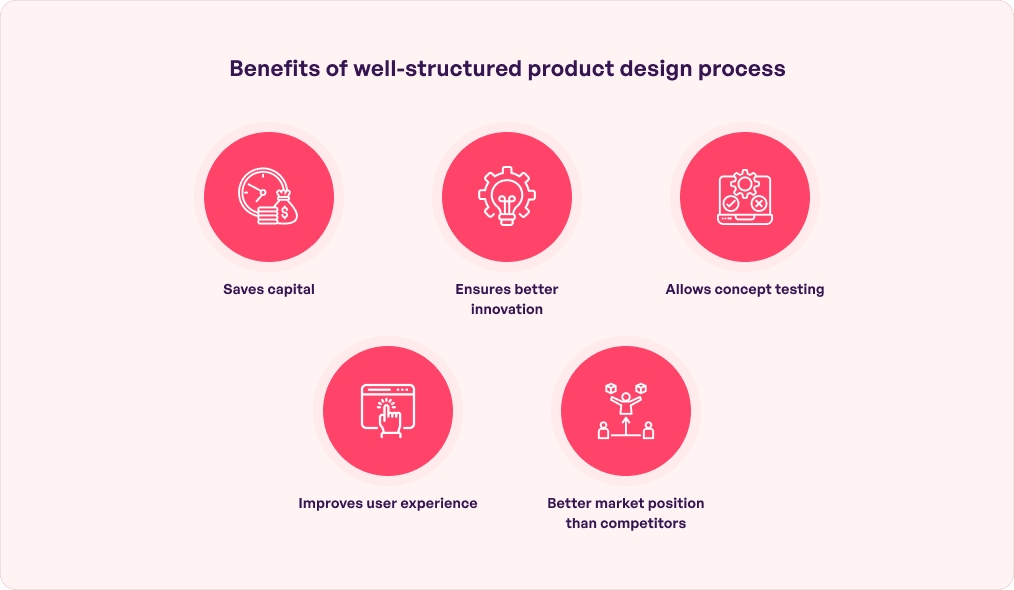 Here’s a look at the principles to follow for the best results.
Here’s a look at the principles to follow for the best results.
Functionality
The primary principle of a digital product design is for it to perform the functions it was intended for. A design that doesn’t make it easy for the users to perform the functions they downloaded the software for, will ultimately fail in the market. A few factors to consider here are efficient navigation, interactivity, global accessibility, real-time updates, and distribution capabilities over the internet.
This is why digital product designers find it important to know the users touchpoints and the in-software movement to ensure that using your software comes naturally to them.
Innovation
It is a key product design principle which involves creating something new or improving upon an existing design in a way that the users get a new in-software experience. The top benefits of innovation include efficiency, growth, competitive edge, and an overall transformational change. Some digital product design examples of this can be seen in Google Maps which brings different elements of a location – direction, photos, and reviews, in one place or even Pinterest which despite being a visually-heavy application makes user movement extremely organic and smooth.
Accessibility
Another digital product design essential to be followed diligently by every UI/UX designer is accessibility – it is the process of making your design accessible to use by a range of users including ones with disabilities. A focus on accessibility doesn’t just make your application inclusive but also opens it to a wider market – all you have to do is to keep people with auditory, visual, and motor impairments in mind when designing your application.
Simplicity
While the most talked about design elements, simplicity is one of the most complex principles to follow through. Designing something that comes intuitively to users and makes them navigate your application without any confusions or frustrations is how you can achieve simplicity. At Simublade, we approach it with minimalistic user interfaces, concise labeling, and an intuitive product design.
The end goal of your design should be to give a friction-less experience to your users, one they can follow without consulting any video or guide. A few burning digital product design examples are Google Go, WhatsApp Messenger, and iAudior which are simple yet making a few millions.
Aesthetics
Factors like textures, color, attractive layouts, content copy, icons, and the overall design directly influence the users’ perception of a software’s usability and value. Moreover, these aesthetic elements act as a source of connection which the users build with the product, encouraging repeat usage and loyalty. The more attractive you design your app to be, the more are the chances of it attracting attention, better interaction, and driving sales. However, keep in mind that as much as aesthetics attract customers, usability is what keeps them hooked to the application. So, strike the right balance between visual appeal and smooth functionality so they complement, rather than overpowering each other.
Branding
The last principle that digital product designers abide by is keeping the designs aligned with branding elements. It is crucial to create a design system at the beginning of the product creation journey and then use it across all the platforms and within the software.
The branding elements that you should focus on to create a brand resonance can be using logo colors as the primary color scheme, brand name in every screen, and similar content copies. All these efforts ultimately result in your digital product standing out in the market with a high resonance count.
Challenges you might encounter in the digital product design process
Designing immersive digital experiences can be challenging, especially since software companies have started using design as their key differentiator. As you move through the digital product design process journey, you might come across a number of challenges which could affect the success of your software.
1. Not knowing your users
One of the biggest challenges that you can face with limited design knowledge is not knowing who you are designing it for. While you might have an idea of their pain points, it is critical to understand factors like –
- Demographics (Boomers, Millennials, or Gen Z?)
- Situations in which they’ll use your software
- Level of urgency in which they will use your digital product
- The conversion points of your product
- Steps they will likely take to achieve the event
2. Lack of feedback
The biggest problem that companies face when it comes to designing is being unsure of whom to take feedback from. Usually, the CEO is the end decision maker when it comes to taking final calls in design approvals. But they don’t often have a dedicated design expertise and there’s a chance that the feedback is irrelevant.
To solve this, it is important to involve real users and the stakeholders who understand the audience or would interact with them in the process. Moreover, you should fix the feedback rounds and timelines to ensure that the deployment speed remains expedited.
3. Allocating time
Developing a worthy digital product requires allocating enough time for a robust outcome. However, entrepreneurs often want a product made within tight deadlines to be able to start serving customers as soon as possible. However, you should have the patience to watch the different steps of the product development process unfold to be able to achieve the key objectives without errors.
Make sure to analyze customer feedback and sales figures to predict business needs and the SDLC methodologies to use right from the start. This offers sufficient time to start building a digital product with a digital product design company instead of starting at the eleventh hour.
4. Hiring a team
Designing a great digital product will require you to hire a team UX designers, copy writers, developers, and testers. Now finding people with expertise in all these fields will take considerable time and investment both in the short run and the long term as they would need constant training.
Out of all these challenges, finding the right people to design your digital product is the most complex issue since there’s a lot that depends on it. Businesses generally tackle this by hiring an outsource digital product design company, since it doesn’t call for any long-term investment or any recruitment or retention efforts.
Let us look into the steps that companies can take to partner with the right digital product design agency.
Basics of hiring a digital product design agency
Finding the right design agency who understands your business goals and your customers is critical for the long-term success of your digital product. While you can get a list of design agencies in the location you wish to outsource your project to through a simple Clutch or DesignRush search, finding the ones who will be a good partner is what would need careful considerations.
Here are some elements you can look into to find the right digital product designers.
Portfolio
Look into the design portfolio the agency has built to get an idea of their innovation abilities and understanding of the audience, market. The portfolio will also give you an idea into their design thinking approach and how updated they are with market trends.
As you study their previous work, we recommend getting in a call with them to know their approach, focus, challenges they faced, etc.
Relevant experience
Even though innovation is how you succeed in the digital product design sphere, there are some industry-wise standards set because of pre-fixed user movements. So it will be helpful to check if the digital product design company you are considering has relevant experience in your industry. Having the same will also help in expediting the design process as the time spent in market research and audience understanding will get shortened massively.
Quote
The time and money product design agency quotes will also play a massive role in your decision to partner with them. Once you have clarity on your budget and design launch timeline, it becomes easier to match your needs with their offerings and decide whether you can partner with them or keep looking for agencies.
In addition, it is also important to understand the payment models ; do they need 50% of the payment upfront, will they follow a module wise payment schedule, or do they have some other model altogether.
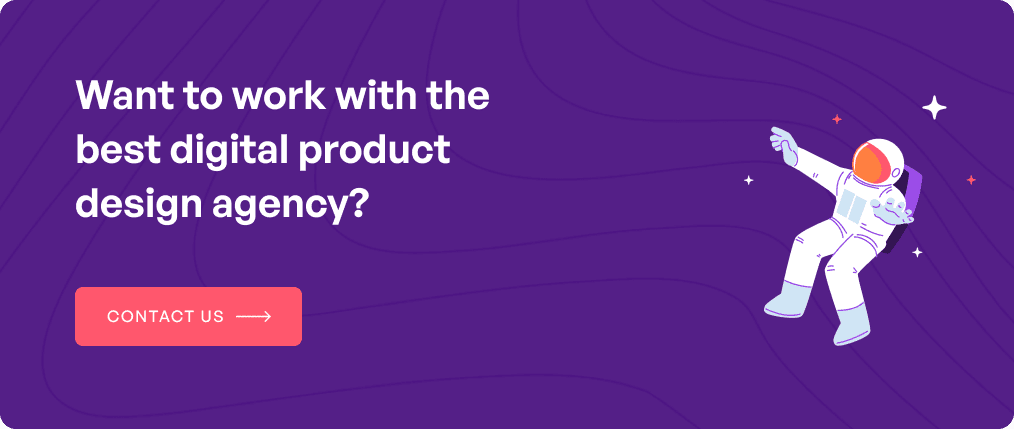 With a clear understanding of these elements it is easier to hire the digital product design agency with a confidence that your investments will not fail. However, we understand how tiresome the process of hiring the right product design agency can get when you get into it on a dedicated level.
With a clear understanding of these elements it is easier to hire the digital product design agency with a confidence that your investments will not fail. However, we understand how tiresome the process of hiring the right product design agency can get when you get into it on a dedicated level.
What if we told you that you can avoid these steps altogether? Well, you can – by partnering with our digital product agency. At Simublade, we have a deep expertise in building immersive digital experiences for businesses across a range of industries and devices. Our team of designers has been the people behind some of the most innovative designs in the digital space, ones that act as a source of attention and conversion.
Additionally, we have a flexible payment model where we let you decide how the association would work, while we focus on giving you a design that reflects your brand image and goals perfectly.
Explore the perks of partnering with us by getting on a design concept creation call.
FAQs
Q. What is product design?
Ans. The process of ‘imagining, creating, and iterating’ products that solve customer pain-points and provide what they desire in software applications or websites is called a digital product design.
Q. What are the essential factors of product design?
Ans. Essentials of digital product design includes customer needs, functionality, UI UX design, aesthetics, wireframes, innovation, and development frameworks. Ethical and legal factors must also be considered for a secure launch.
Q. What is the methodology of digital product design?
Ans. The methodologies followed by product designers include creating and iterating products that entrepreneurs have outlined in their heads. For this, they can follow several methodologies like Agile, Waterfall, Spiral, Lean, Iterative, and DevOps,
Q. What is the process of designing a digital product?
Ans. The digital product design process includes different steps like discovery, ideation, research, creation, deployment, testing and post-launch maintenance.
Q. 5 Steps of the Design-thinking Process
Ans. The 5 steps of the digital product design thinking process are : Empathize, Define, Ideate, Prototype, and Test.



